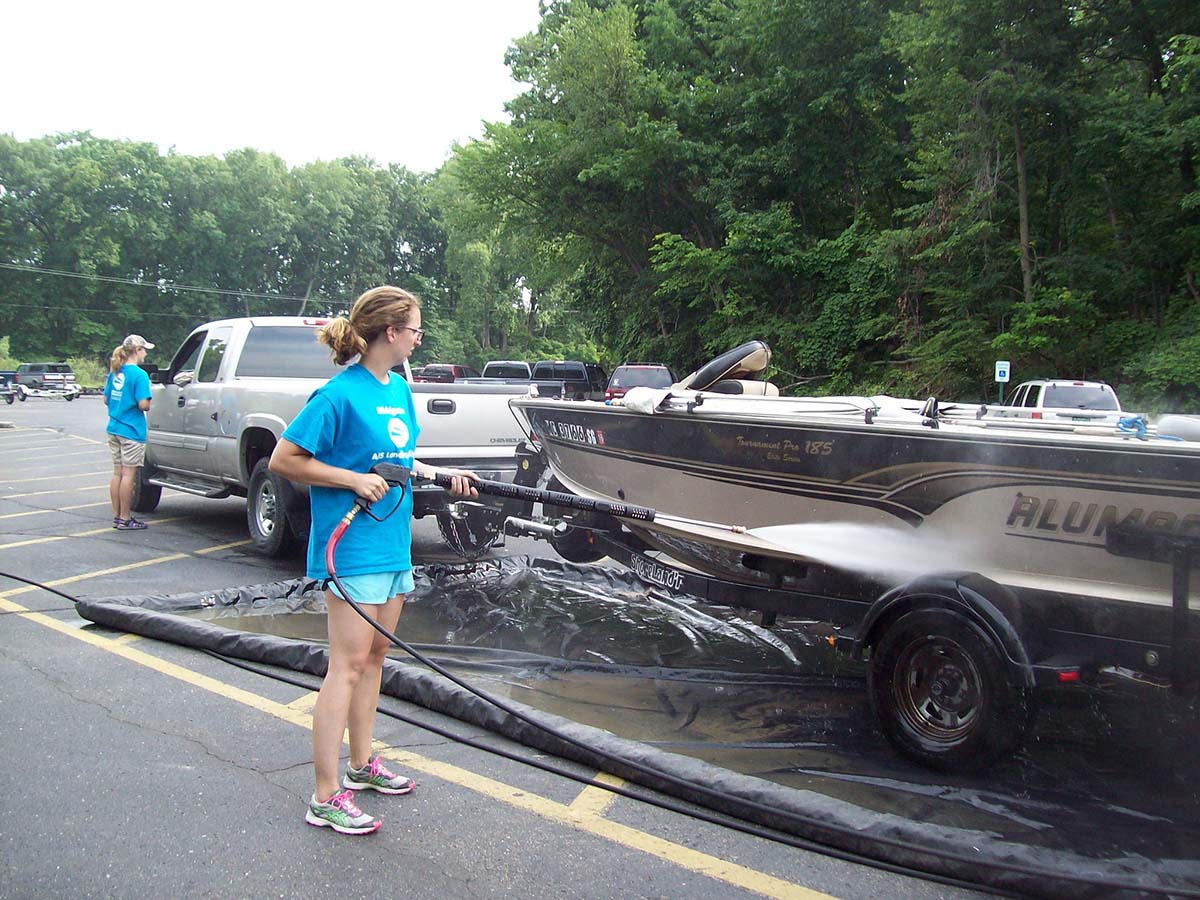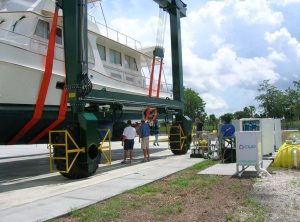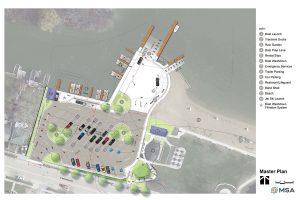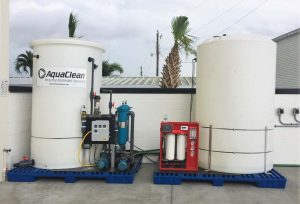
Boat Washing and the Environment
Published on May 1, 2023In 1972, the National Pollution Discharge Elimination System (NPDES) was created as part of Section 402 of the EPA’s Clean Water Act. The program clearly states, “NPDES prohibits [discharges] of pollutants from any point source into the nation’s waters except as allowed under an NPDES permit.” The rule pertains mainly to industrial activities — those that generate water pollution and degrade surface water by direct contact with a hazardous substance.
Do marinas and boatyards participate in “industrial” activities? Those with boat- or equipment-washing practices do, depending on systems in place and adherence to the rules.
The reasons for boat washing are multifold, ranging from routine cleaning and maintenance to preparing vessels for seasonal storage or removing marine growth and aquatic invasive species. These practices are imperative, no doubt, and protect the integrity of our waters from non-native species that can threaten their health. But there are other risks associated with boat washing and a list of NPDES pollutants that stem from boat bottom paints and finishes that either shake loose during pressure washing or rinse off at the same time, like petroleum hydrocarbons.

Unfortunately, marine hard bottom paints, ablative bottom paints (also known as self-polishing), and antifouling coatings all pose some level of concern, with ingredients such as copper, irgarol (an antimicrobial pesticide), and other biocides that can contaminate water bodies. There are other culprits as well.
Lead, tin, zinc, chromium, and other metallic compounds are additional ingredients found in marine products — and equally apt to flake off in small particles during power washing. Each of these can bio-accumulate in water, sediment, fish, and other marine organisms, adversely affecting water quality and the well-being of the greater food chain. This is why the Clean Water Act exists and why marinas and boatyards should feel compelled to comply with regulations.
Boat Wash Discharge Options
Boat washing programs aren’t going anywhere, so it’s up to marinas and boatyards to determine a system that works best for their needs, size, and budget.
• Collect, Contain, and Haul. This system involves containing all onsite wash water and arranging for it to be hauled away. It typically requires installing a large above-ground storage tank, somewhere between 2,000-5,000 gallons in size, and contracting with a licensed waste hauling company to take the contaminated water to an approved wastewater facility.
• Treat and test all water for approval to be discharged to surface and/or ground waters. Operations that can prove the full elimination of exposure to water from industrial activities can apply for a permit from NPDES for basic industrial stormwater discharge. Regulations are understandably strict and vary from state to state. A marina or boatyard would need to develop and implement comprehensive best management practices (BMPs) with clearly measurable goals, prepare a Stormwater Pollution Prevention Plan (SPPP), conduct intensive employee training, and undergo regular facility inspections. If violations are found, the marina or boatyard will face penalties.

• Discharge the waste wash water to a municipal sanitary sewer authority. This is not always an option and requires rigorous pretreatment and testing, particularly when toxic metals and solids from ablative paints are present. Most regulations allow for a 20% discharge to sanitary sewers, provided a marina or boatyard acquires the proper permits and conducts testing.
• Install a closed-loop water recirculating system. This utilizes a catch basin or sump pit to collect wash water from a wash pad and continuously recycle it back through the loop. The arrangement removes pollutants, which settle into the catch basin, and pumps filtered water to be reused for washing operations — all without the use of noxious chemicals. The water is never released to any surface water area; it is wholly contained and internally cleaned — an excellent way to meet environmental standards and NPDES compliance.
Anatomy of a Boat Wash Pad
Whichever boat wash and discharge practice is selected, each will require a boat wash pad. Marinas and boatyards can have a permanent wash pad designed and engineered to meet their capacity needs. Generally speaking, the more vessels an operation houses, the larger the wash pad required.
Existing wash pads can be retrofitted or enlarged as a marina grows, which is a smart way to save money. Or, a portable or temporary wash pad can be used, provided it rests upon an impervious area and all wash water can be removed via pump or vacuum from the collection area.

The following are some best practices for wash pad designs. First, the pad must be engineered and constructed to handle the weights and loads of all sizes of vessels, forklifts, travel lifts, and cranes — sometimes simultaneously. Secondly, it must be comprised of (or sitting on top of) impervious materials such as concrete, plastic, rubber, or asphalt and must be able to support heavy use from tires, trailers, boats, and equipment.
The goal is to capture and contain wash water while also responsibly separating and discharging rain or stormwater. The wash pad itself is the perfect first line of defense for filtering out large particles, which can be cleaned from the surface daily. This initial filtering stage only works with the proper slope. Best design practices recommend 1/8” of slope per every foot of wash pad length.
Troughs should also be incorporated into the wash pad design, whether as raised troughs or center troughs. Here, wash water enters the troughs through a series of holes or grates, sometimes embedded with bag filters, which can be closed when not in use so as not to take on stormwater. The wash water is then diverted to phase two of the marina’s set-up, whether that is a recycling system, storage tank, or sanitary sewer network.
A critical component of wash pad design and general site layout is considering what happens with stormwater runoff. Implementing dedicated stormwater best management practices (BMPs) in tandem with a marina’s boat-washing design will help ensure that runoff on the property is properly channeled, contained, or diverted.
Closed-loop Boat Wash Systems
Marinas have options when it comes to boat wash systems and wash pad designs. They also have a responsibility to operate within regulation and within budget. Marinas and boatyards should also be responsible for helping to protect — if not improve — the country’s waters as well. A closed-loop boat wash system is the most environmentally sound and sustainable means to do so.
It’s all about recycling and reusing water without chemical treatment and without compromising a quality wash. A closed-loop system like AquaClean™ from EMP Industries, for example, is designed and engineered specifically for the purpose of handling marine boat wash runoff from any size marina, boatyard, or dry storage facility. It starts by capturing residual heavy solids left on the boat wash pad and diverting them into a dedicated above-ground settling tank. These tanks range from 500 to 1,000 gallons, fitted to each marina based on their size, amount of run time washing boats, and the gallon-per-minute flow of the associated power washers. Smaller particles (100 microns or 1/10 of a millimeter in size, like a dust particle) are caught by entry filters before being passed on to a dedicated storage tank while even finer particles (10 microns in size) are trapped within a polishing filter.
This step-down filtration process captures varying sizes of solids and contaminants at different stages before transferring water into the recycling system. Here, water automatically and continuously circulates, running through an ultra-violet (UV) light treatment and bromine oxidation unit to mitigate bacteria and organic growth, remove trace metals and oils, and eliminate odors. The newly cleansed water is then pumped to the spray equipment — a pressure-washing system that can support multiple washers with a flow rate of 15 gallons per minute.
EMP also offers a smaller version of the AquaClean called the AquaHaul™, which is an option for low-volume or seasonal haul-out operations that only need one or two pressure washers. Like its bigger sibling, this system is self-contained and closed-loop, with the same “green” treatments and gallon-per-minute pressure capacity. Both products are a cost-effective way to save on utility costs while also readily complying with NPDES permitting.
Which System is Best for Me?
Marina operators need to weigh a variety of factors when making this decision: staffing and maintenance time, budget, available space, cost and frequency of haul-away or sanitary sewer disposal, environmental fees, and more.
If boat washing is a regular guest service and source of revenue, a marina might be a great candidate for a closed-loop system. If boat washing is incidental or infrequent, a collect-and-haul-away service might be all that is needed.
The goal is to reduce, if not stop, harmful contaminants from entering our waters. Since commercial and industrial greywater runoff is an increasing contributor to global water pollution, we all play a role in changing our products and practices for the better.
Dan Williams, PLA, ASLA, AHLP is senior landscape architect at MSA. He can be reached at dwilliams@msa-ps.com. Tom Callahan is president of EMP Industries, Inc. He can be reached at tom.callahan@empind.net. Aaron Kravitz works in sales at EMP Industries, Inc. He can be reached at akravitz@empind.net.
| Categories | |
| Tags |





